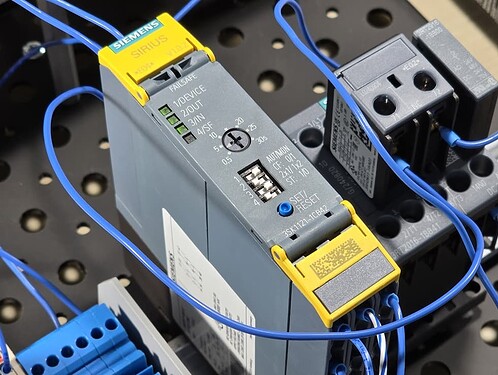Introduction to the Siemens Safety Relay T1 and T2 Signals
The Siemens SIRIUS 3SK family of safety relays is designed for machine guarding. Most modules include a pair of test signals designated at T1 and T2. These signals are at the heart of safety integrity:
-
The two signals are sent to a device such as an E-stop.
-
The two signals pass through independent switch contact blocks.
-
The two signals return to the safety relay via the In1 and In2 connection.
How does a safety relay ensure integrity?
The T1 and T2 signals are pulsed as shown in Figure 1 so that the system can detect anomalies including:
-
Press of the E-stop
-
Open in either T1 or T2
-
Short to 24 VDC
-
Short to the 24 VDC return (ground)
-
Short from T1 to T2
In all cases, the safety relay or associated expansion module enters a fault state. This will place the corresponding equipment in a safe state. Here safe is determined by the initial hazard assessment for the equipment or process.
Figure 1: Oscilloscope view of the T1 and T2 signals originating from a Siemens 3SK1 safety relay.
Description of the T1 and T2 signal waveforms
The Siemens safety relay waveforms are shown in Figure 1. Observe:
-
A pulse repetition period of 10 ms.
-
T1 and T2 rising edge coincidence (synchronized).
-
The pulse width alternates between approximately 1.5 and 4 ms.
-
T1 and T2 are out of phase so that a long pulse is accompanied by a short pulse.
What is the response time of the Siemens 3SK1 Safety Relay?
Based on the waveforms, we can expect a missing or corrupt pulse to be detected within about 10 ms. However, this is only for the systems using the T1 and T2 signals. We can expect Output Signal Switching Device (OSSD) devices such as a light curtain to take longer as the measured pulse repetition rate is in the 100 ms neighborhood.
Which device was used for these measurements?
The measurements were made on the author’s workbench using a Siemens 3SK1121-1CB42 along with a Digilent ADP2230 mixed signal oscilloscope.
Figure 2: Image of a Siemens SURIUS 3SK1121-1CB42 on the author’s workbench.
![]() Article by Aaron Dahlen, LCDR USCG (Ret.), Application Engineer at DigiKey
Article by Aaron Dahlen, LCDR USCG (Ret.), Application Engineer at DigiKey


